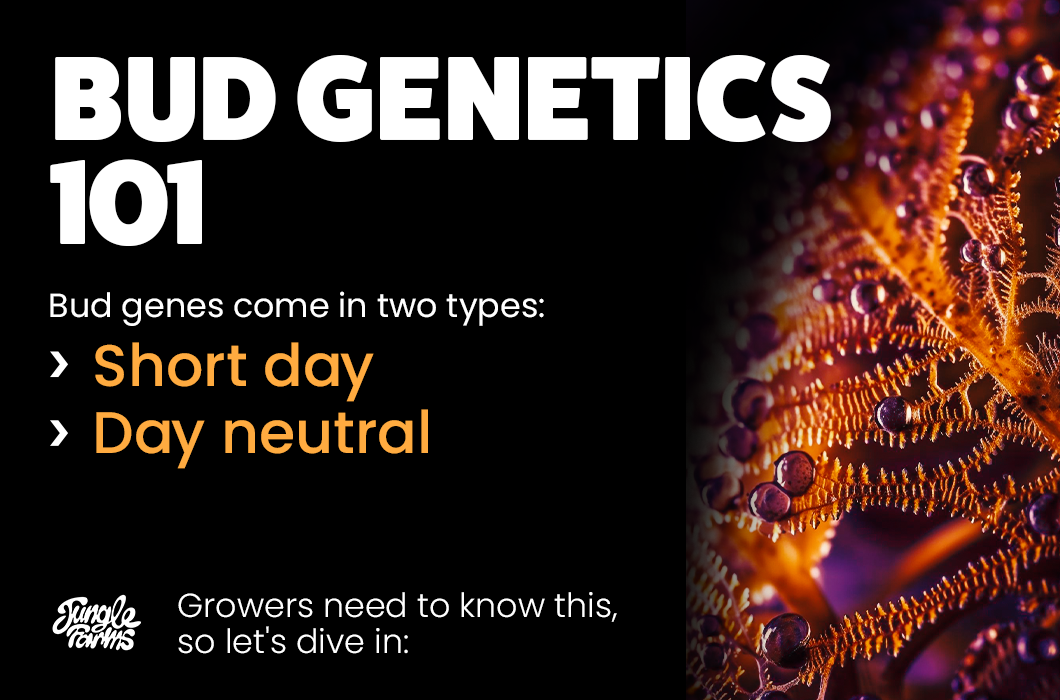Cannabis cultivation intricately relies on genetics, emphasizing their pivotal role in attaining optimal harvests. Growers aspiring to boost yields delve into the distinctive attributes of both short-day and day-neutral buds. A deep understanding of these genetic nuances proves paramount for those striving to prosper in the cannabis cultivation sector. This Genetics 101 series endeavors to highlight the significance of plant varieties like short-day and day-neutral buds, equipping growers with knowledge and fostering awareness about the diverse types of plants suitable for cultivation.
Short Day Buds
Short-day varieties, also known as full-term or photoperiod determinant buds, follow a specific flowering pattern dictated by daylight duration. These plants initiate the flowering process when the day length is less than 14 hours. This means that as daylight hours decrease during the fall season, short-day buds respond by transitioning from vegetative growth to the flowering stage.
The key here is not to be swayed by random fluctuations but to understand the precise trigger mechanism that short-day buds respond to. Growers need to be assertive in their knowledge of how these buds operate in varying light conditions, ensuring that the cultivation environment aligns with the natural cycles these plants follow.
Day-Neutral Buds
Day-neutral buds present a fascinating adaptation to varying day lengths, originating from Siberian regions where summer days can stretch beyond 20 hours of daylight. This unique genetic trait allows day-neutral buds to initiate flowering regardless of day length, making them popularly known as autoflowers.
The adaptability of day-neutral buds is a game-changer for growers dealing with unpredictable light conditions or cultivating in regions with extreme variations in day length. This genetic flexibility provides a practical advantage, giving growers more control over the flowering cycle and allowing for a more tailored cultivation experience.
Optimizing Growth Conditions
Now, armed with the knowledge of short-day and day-neutral buds, it becomes paramount for growers to understand how to create the optimal conditions for each genetic variation.
Short-day buds thrive in environments where the day length decreases, mimicking the natural conditions that trigger their flowering phase. Growers must assertively manage the light cycles, ensuring that the transition from vegetative growth to flowering is synchronized with the changing seasons.
On the other hand, day-neutral buds offer a more forgiving approach. Understanding that they initiate flowering regardless of day length provides growers with the freedom to cultivate in various light conditions. However, this adaptability doesn’t mean neglect; it means growers need to assertively tailor their cultivation strategies to harness the benefits of day-neutral genetics.
Strategic Cultivation Practices
To successfully cultivate cannabis, growers must not merely explore but implement strategic cultivation practices.
For short-day buds, meticulous attention to the natural light cycle is key. This isn’t about orchestrating a symphony of complex procedures; it’s about observing and understanding the simple rhythm of nature and aligning your cultivation practices accordingly.
Autoflowers, or day-neutral buds, demand a different approach. Instead of embarking on intricate strategies, growers should focus on flexibility and adaptability. The genetic resilience of day-neutral buds allows growers to respond to changing conditions without the need for meticulous adjustments.
Conclusion
In the realm of cannabis cultivation, the importance of bud genetics cannot be overstated. Understanding the inherent characteristics of short-day and day-neutral buds is not a mere exploration but a practical necessity for any serious grower.
The imperative lies in the hands of the growers to actively apply this knowledge to their cultivation practices. It’s not about ushering in a seismic shift but about aligning with the genetic predispositions of the buds to elevate the quality and yield of the harvest.
In essence, Bud Genetics 101 is a guide for growers to assertively navigate the intricacies of cannabis genetics, ensuring a successful and optimized cultivation experience. So, know your buds, understand their genetic language, and cultivate with confidence. Your harvest will thank you.

